Whales are some of the most fascinating creatures on the planet. If you have ever seen one in person you understand the magnitude of these massive animals. Whale watchers travel the globe, following the migrations of various whales, while coastal residents have the pleasure of watching large pods of whales visit their waters every year. Not all whales migrate but many whale species make long journeys every mating season, some as long as 10,000 miles or more round trip. Let’s take a look at a list of common whales, where they live, and where to find the best whale watching!
What Are Whales?
Whales include a variety of mammals in the cetacean family that include whales like blue, gray, and fin whales, but did you know orca, porpoises, belugas, narwhals, and dolphins are all whales too? Whales are grouped into two categories, toothed whales and baleen whales. Toothed whales include sperm whales, belugas, dolphins, orca (which are actually a kind of dolphin), porpoises, and narwhal. They are characterized by their teeth and typically hunt for their food. Baleen whales don’t have teeth but instead use a baleen plate as a sieve to sift the ocean water for zooplankton and krill. Whales like the blue whale, bowhead, and right whale are all baleen whales. Whales range in size from the smallest dwarf sperm whale that is 6.6-8.9 feet to the largest blue whale that can reach lengths of almost 100 feet!
Where Do Whales Live?
Whales live in every ocean on the planet including the coolest waters of the Antarctic Ocean and Southern Ocean. Some whale species live deep in the ocean, making dives nearly 10,000 feet deep, while others prefer shallow waters near shore. As mammals, all whales need to breathe air. So, while some whales are deep divers, they do need to surface to breathe. Sperm whales can hold their breath for up to 90 minutes! Gray whales and humpback whales are frequently seen near shore, although they can live in deeper waters during migrations.
Most whales are marine mammals, meaning they live in the ocean, but one group of whales, river dolphins, are freshwater mammals. The Amazon River dolphin lives in the freshwater Amazon in South America and the Gangus and Indus River dolphins live in their namesake rivers in South Asia.
Blue Whales

©iStock.com/MR1805
The blue whale is the largest of all the whales. In fact, they are the largest animal on Earth at 98+ feet long. Blue whales live in the Pacific, Atlantic, Indian, and Southern Ocean, but not in the Arctic. The population in the Southern Ocean are some of the largest. During the summer months, you can see blue whales along the California coast, with a large population of around 2,000 making their home in Monterey Bay. During the winter months, the blue whale migrates south to the coast off of Mexico and Central America.
In the southern hemisphere, blue whales can be found feeding in the cool waters around Antarctica and then migrating closer to the equator when it gets too cold. The long coast of Chile is one area that welcomes blue whales, depending on the time of year. Blue whales also live around the coasts of Patagonia on both the Chile side and Argentina side.
Humpback Whales
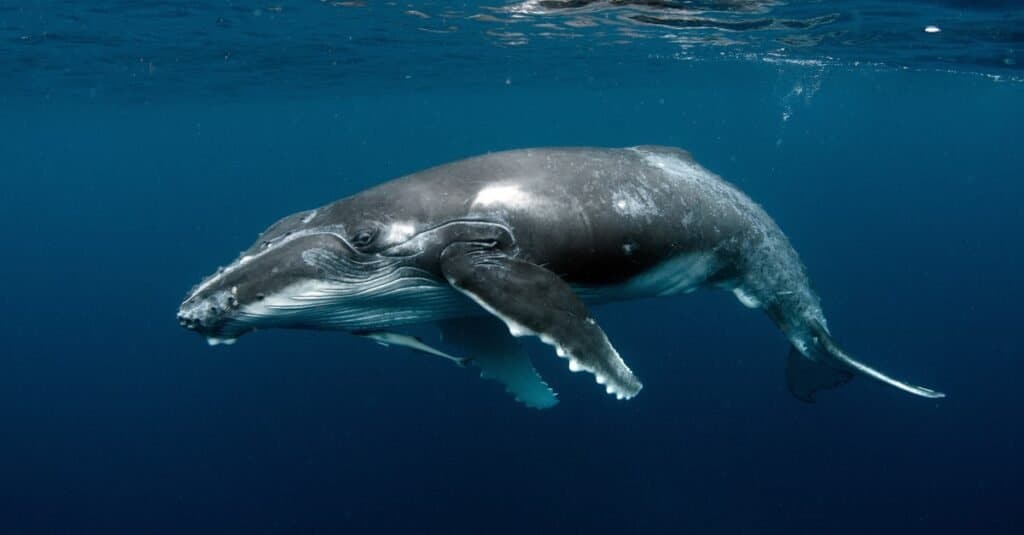
©Tomas Kotouc/Shutterstock.com
Humpback whales are popular because of their showstopper quality. They can breach the ocean waters spinning in the air and come crashing down to make a magnificent splash. Humpbacks also use their long front flippers and tail flukes (which can get to be 18 feet wide!) to slap the water and make waves.
Humpbacks have some of the longest migrations with whales traveling more than 5,000 miles one way. Humpback whales live in the North Pacific Ocean near Alaska in the Bering Sea during the warmer months and travel south to Hawaii during the winter. Some populations end up off the coast of Mexico and Central America. Other populations travel to the warmer waters around Japan. On the other side of the U.S., the populations in the Atlantic may spend the summers off the northeast coast of the U.S. and east coast of Canada. You will also find them in the chilly waters of Iceland, Greenland. and Norway. This group heads south to the Caribbean, with some going down as far as Venezuela.
Gray Whales

©Mogens Trolle/Shutterstock.com
Gray whales are also migrators. They are impressive to see, especially in a large pod! They summer in the rich feeding areas of the North Pacific, around Alaska, then travel down along the coast to the warmer waters off the coast of Mexico in the winter. Their migrations can be as far as 6,000 miles one way and another 6,000 on the way back. The gray whale is one of the most frequently seen whales in the Monterey Bay area of California. One of the most common times to see gray whales off the coast of California is between January and March. Gray whales can get to be 46 feet long and weigh 35 tons. You can charter a whale tour to get up close and personal with these magnificent creatures!
Sperm Whales
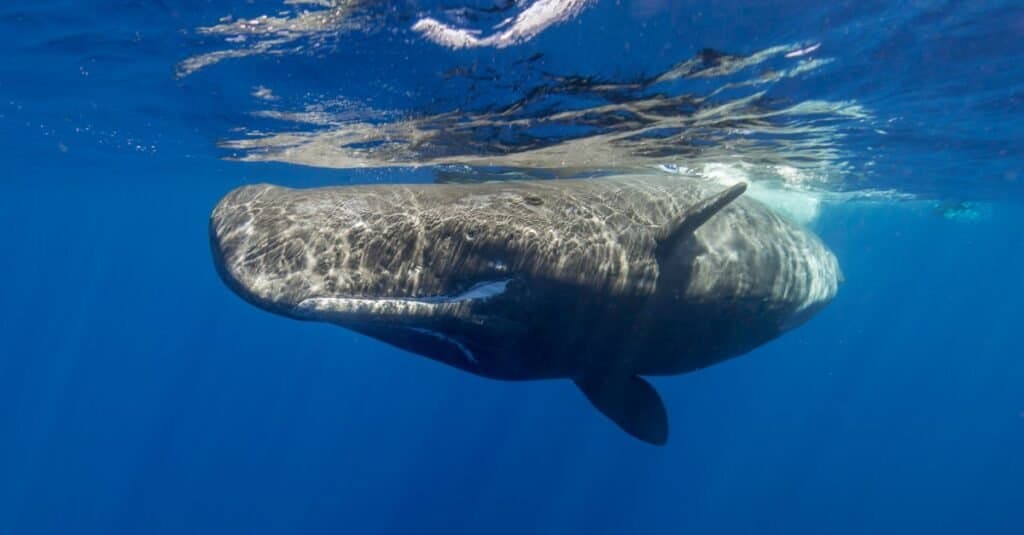
©wildestanimal/Shutterstock.com
The sperm whale is the third largest whale and the largest toothed whale. They have an enormous top-heavy head with a comparably small mouth at the bottom. Sperm whales live in all the oceans including the Arctic. They have one of the widest ranges of all the whales. Female sperm whales and their young live in the same place year-round while the males are the ones to migrate. Their locations are less predictable than some of the blue and humpbacks that routinely make the same journey. Sperm whales are deep divers, so they are less often seen out in the open. They have feeding grounds off the coasts of Norway and New Zealand.
Beaked Whales
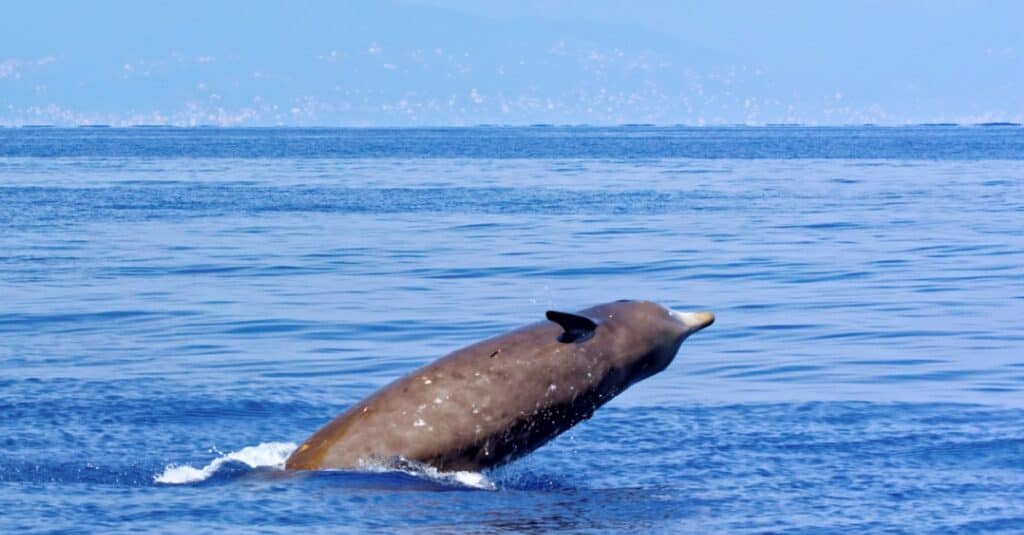
©iStock.com/HeitiPaves
Beaked whales are deep sea dwelling mammals. Because they spend much of their time far out in the ocean, our information regarding them is limited. The Cuvier’s beaked whale is the most studied of the beaked whale species. They live all over the world, but it is unclear if they have predictable migrations. Based on strandings, it is clear that they live both in the Northern and Southern Hemispheres. They live around the Aleutian Islands of Alaska, off the coast of British Columbia, in the Gulf of California, in the Gulf of Mexico, and the throughout the Mediterranean Sea. Known populations have been found living off the coasts of New Zealand and South Africa as well.
Bottlenose Dolphins

©iStock.com/NaluPhoto
Bottlenose dolphins are one of the most common oceanic dolphins. Theses seemingly smiling mammals live in the Pacific, Atlantic, and Indian Ocean but avoid the coldest waters near both poles. They really are pretty versatile and can live in a variety of habitats. Bottlenose dolphins can live along the coast close to shore and they can live further off coast. Dolphins that live along the coast will often spend time in bays and estuaries. Bottlenose dolphins also live in gulfs and seas like the Gulf of Mexico and the Mediterranean Sea. It is common to find bottlenose dolphins living together in pods of two to 30 dolphins.
River Dolphins

The small group of river dolphins is unique because they are the only freshwater whales. The Amazon River dolphins are sometimes called pink dolphins because of their pinkish tint. They have longer snouts and larger, wider pectoral fins. Amazon River dolphins live in the Amazon River basin and the Orinoco River basin in South America. This includes the countries of Venezuela, Columbia, Ecuador, Brazil, Bolivia, Guyana, and Peru.
The Gangus River dolphin lives in Nepal, Bangladesh, and India in the Gangus River and its tributaries. Due to many dams built along the Gangus, many populations are isolated from one another. The Indus River dolphin used to have a larger range but now is limited to the lower and middle sections of the Indus River and its tributaries in Pakistan and India.
Killer Whales

©Nick Grobler/Shutterstock.com
Killer whales, or orca, live in all the oceans on the Earth but they are more common in the cooler regions. Large populations can be found off the coast of the northwest states like Washington and Oregon and up the coast of Canada to Alaska. Populations can also be found off the cool coast of Norway and in the Southern Ocean in some of the chilliest conditions. But just because they are more common in cooler waters doesn’t mean they don’t also live in warm tropical waters. Killer whales live around Hawaii, Florida, Australia, and the Bahamas.
One group of killer whales that lives off the Valdes Peninsula in Argentina is noted for their unique hunting technique. If you are visiting that area between February and early May you may witness killer whales that slowly swim up to the shoreline and hide in the waves, waiting for an unsuspecting seal pup. Once they catch a seal, they float back out to sea with the next incoming wave. Killer whales are known to work together in pods to hunt and catch prey. They will even take on great white sharks!
Porpoises

©Elise V/Shutterstock.com
Porpoises look a lot like dolphins but there are a few key differences. The most obvious difference is the long snout of the dolphin compared to the “flat face” of the porpoise. Porpoises also have a heavier build, whereas dolphins look slimmer and more streamlined. The dorsal fin of the porpoise is more triangular, while the dolphins’ is curved pointing backward. In the U.S., porpoises live off the eastern coastline as well as the cooler waters off the coast of Alaska. They also live off the western coast of Africa up to Europe and Greenland in the North Atlantic Ocean. Because they live near the shoreline, they also venture into bays, estuaries, and even some rivers. Porpoises only get to be around 6 ½ -7 ½ feet long, a little longer than your average scuba diver!
Beluga
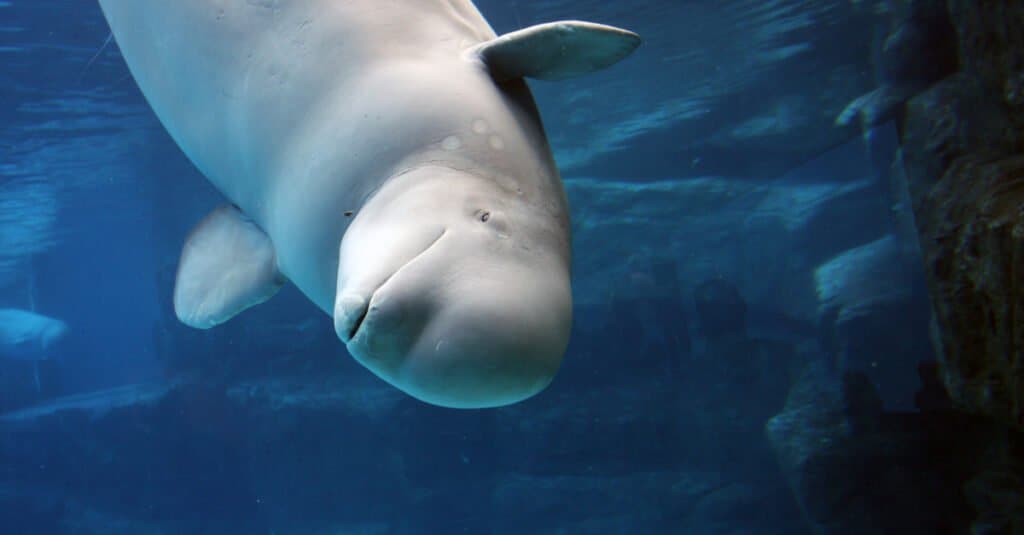
©Christopher Meder/Shutterstock.com
Beluga whales are one of the sea mammals you will only find in the Northern Hemisphere. Belugas live in the Arctic Ocean off the coast of Alaska as well as Canada, Russia, and Greenland. They often live in large pods but are flexible in switching from pod to pod. Some beluga populations will return to their birthplace for calving the next generation while others are residents in the same area year-round. Compared to dolphins, belugas are just a tad smaller with an average length of 5-8 feet (while dolphins are 8-13 feet).
Interestingly, Belugas seem to have facial expressions similar to humans with an ability to use the muscles in their face to smile and make other facial expressions. The bones in their neck aren’t fused like other whales, so they have a lot of flexibility in their movements, making them seem even more expressive!
Narwhal
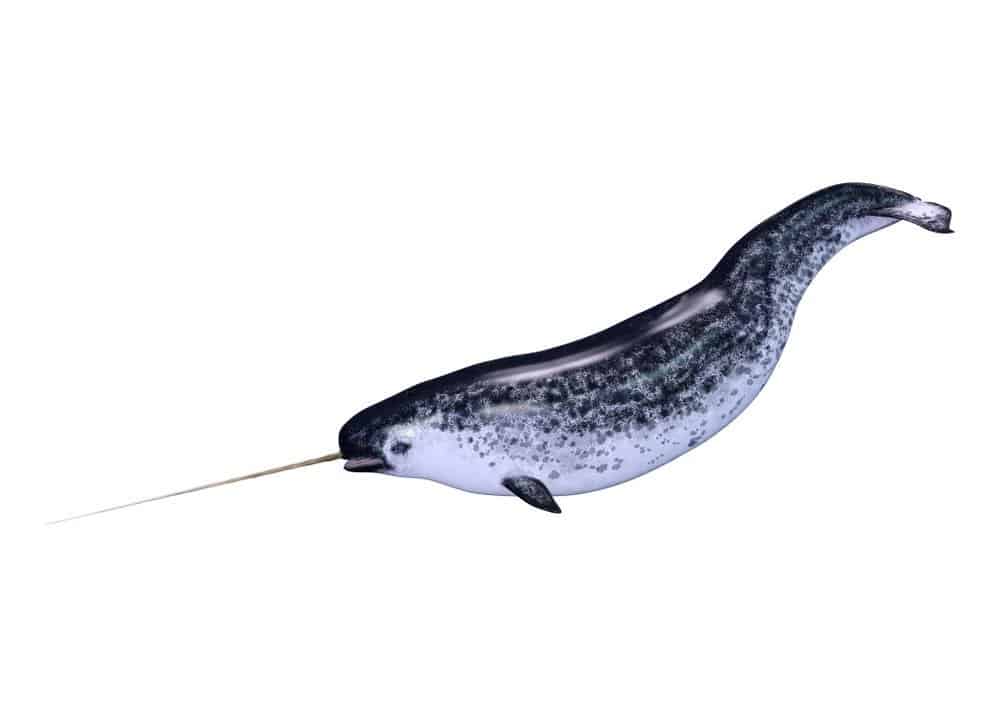
©iStock.com/Vac1
Narwhals are in the whale family. In fact, narwhal and beluga are in the same family, Monodontidae, and both have the same body shape and similar size. However, there is one obvious difference between the two. If you saw a male narwhal and beluga next to each other, you would not be scratching your head trying to tell them apart! Male narwhals have what looks like a long sword jutting out from their face. The sword is actually an overgrown tusk that is spiral shaped and quite sharp at the end. Some narwhal tusks can get to be 10 feet long!
The narwhal habitat is similar to that of the beluga in the cool arctic waters in the Arctic Ocean. Narwhals live off the coast of Norway, Russia, Canada, and Greenland. One interesting fact about narwhals is they live under the sea ice for about five months of the year. During this time, they hide out between Western Greenland and Canada in the Baffin Bay-Davis Strait. Narwhals are larger than dolphins and beluga, coming in around 16 feet long, and that is without their tusk!
The post Whale Location: Where Do Whales Live? appeared first on AZ Animals.
from Animal News, Facts, Rankings, and More! - AZ Animals https://ift.tt/WyZioXt